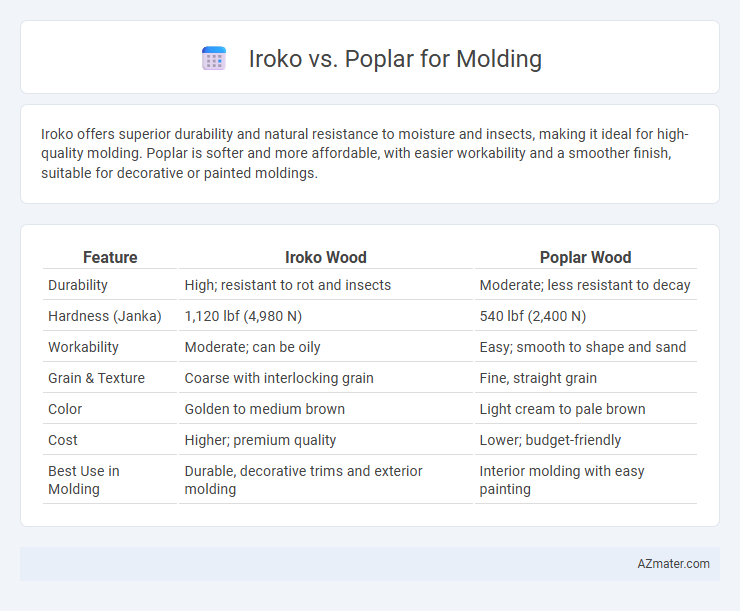Iroko offers superior durability and natural resistance to moisture and insects, making it ideal for high-quality molding. Poplar is softer and more affordable, with easier workability and a smoother finish, suitable for decorative or painted moldings.
Table of Comparison
| Feature | Iroko Wood | Poplar Wood |
|---|---|---|
| Durability | High; resistant to rot and insects | Moderate; less resistant to decay |
| Hardness (Janka) | 1,120 lbf (4,980 N) | 540 lbf (2,400 N) |
| Workability | Moderate; can be oily | Easy; smooth to shape and sand |
| Grain & Texture | Coarse with interlocking grain | Fine, straight grain |
| Color | Golden to medium brown | Light cream to pale brown |
| Cost | Higher; premium quality | Lower; budget-friendly |
| Best Use in Molding | Durable, decorative trims and exterior molding | Interior molding with easy painting |
Introduction to Iroko and Poplar Woods
Iroko, a dense hardwood native to West Africa, is renowned for its durability, rich golden to medium brown color, and natural resistance to decay, making it an excellent choice for molding in high-moisture environments. Poplar, a softer hardwood commonly found in North America, features a lighter color palette ranging from creamy white to yellowish green, offering ease of carving and affordability for interior molding applications. The choice between iroko and poplar depends on the desired strength, appearance, and environmental conditions of the molding project.
Key Characteristics of Iroko for Molding
Iroko is a durable hardwood known for its high density, natural resistance to decay, and excellent dimensional stability, making it ideal for molding applications in both interior and exterior environments. Its coarse texture and interlocking grain pattern provide a smooth finish that can be easily sanded and finished to enhance aesthetic appeal. The wood's natural oils contribute to its resistance to insects and moisture, ensuring long-lasting performance and minimal maintenance.
Essential Properties of Poplar for Molding
Poplar wood features a fine, even texture and a straight grain, making it ideal for detailed molding work. Its moderate hardness and excellent workability allow for smooth cutting and shaping without splintering, while its light color offers versatility in finishing options such as staining or painting. Poplar's stability and resistance to warping ensure durable and precise molding, especially in interior applications.
Durability: Iroko vs Poplar
Iroko wood exhibits superior durability compared to Poplar, offering high resistance to decay, moisture, and insect attacks, making it ideal for long-lasting molding. Poplar, while easier to work with and more affordable, is softer and less resistant to wear and environmental factors, leading to a shorter lifespan in molding applications. The natural oils and dense grain of Iroko contribute to its robustness, making it a preferred choice for durable, high-quality moldings in both interior and exterior settings.
Workability and Ease of Machining
Iroko wood offers excellent workability with moderate hardness, allowing clean cuts and smooth finishes for molding projects, but it may require pre-drilling for nails due to its density. Poplar is softer and easier to machine, providing superior ease in shaping, sanding, and nailing, making it an ideal choice for intricate molding with minimal effort. Both woods hold paint well, yet poplar's consistent grain reduces the risk of splintering, enhancing overall workability in detailed molding applications.
Aesthetic Appeal and Grain Comparison
Iroko features a rich golden to medium brown hue with a coarse, interlocking grain pattern that adds a distinct, textured aesthetic to moldings, offering durability combined with visual interest. Poplar presents a pale cream to light brown color with a smooth, straight grain, resulting in a more uniform and understated appearance ideal for painted moldings. The choice between Iroko and Poplar depends on whether a natural, bold wood grain or a subtle, consistent finish is preferred for the molding project.
Cost and Availability
Iroko offers higher durability but comes with a significantly higher cost compared to Poplar, making it less accessible for budget-conscious projects. Poplar is widely available in North America and costs considerably less while still providing good workability for molding applications. Choosing Poplar can reduce expenses and ensure easier sourcing, whereas Iroko's premium price reflects its superior resistance to wear and moisture.
Suitability for Paint and Finishing
Iroko offers excellent paint adhesion due to its relatively open grain and coarse texture, making it suitable for detailed molding with smooth finishes. Poplar is highly favored for molding that requires painting, as its soft, fine-grained surface accepts paints and veneers uniformly, resulting in a flawless finish. Both woods provide reliable options, but Poplar's consistent grain enhances paint durability, while Iroko's natural oils may require additional surface preparation for optimal paint adherence.
Environmental Impact and Sustainability
Iroko wood, sourced from tropical African forests, is often considered more environmentally sustainable due to its durability, which reduces the need for frequent replacement in molding applications. Poplar, being a fast-growing temperate species commonly cultivated in managed plantations, offers a lower carbon footprint through quicker growth cycles and efficient reforestation practices. Despite Iroko's strength, Poplar's renewability and lower impact on biodiversity position it as a more eco-friendly choice for sustainable molding projects.
Best Applications for Iroko and Poplar Moldings
Iroko moldings excel in outdoor and high-moisture environments due to their natural resistance to decay and insect attacks, making them ideal for exterior trim, decking, and marine applications. Poplar moldings are best suited for interior projects such as cabinet frames, door casings, and window trim, valued for their smooth surface and excellent paint adherence. Selecting Iroko ensures durability and weather resistance, while Poplar offers versatility with easy customization and cost-effectiveness for indoor moldings.

Infographic: Iroko vs Poplar for Molding
 azmater.com
azmater.com